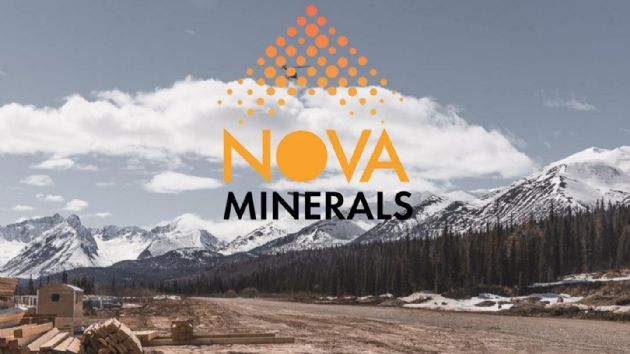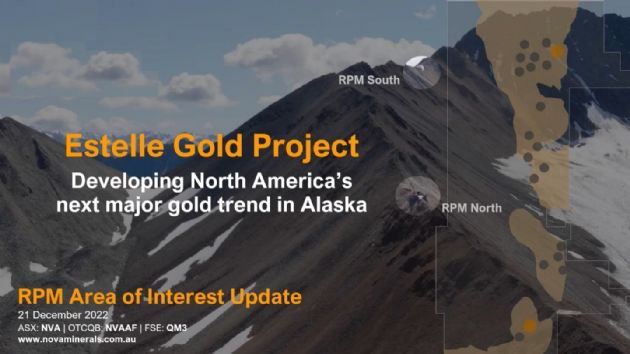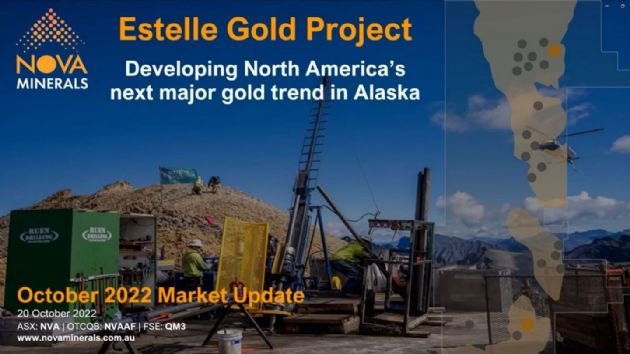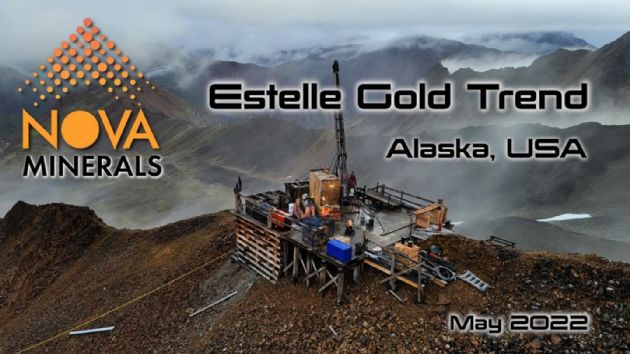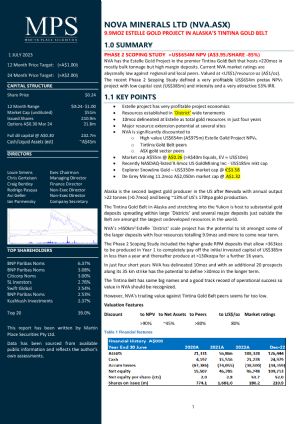 Further Significant Drill Results from Snow Lake Lithium
Further Significant Drill Results from Snow Lake Lithium
Melbourne, May 20, 2022 AEST (ABN Newswire) - Nova Minerals Limited ( ASX:NVA) (
ASX:NVA) ( QM3:FRA) (
QM3:FRA) ( NVAAF:OTCMKTS) advices 37% owned Snow Lake Resources Ltd., d/b/a Snow Lake Lithium Ltd. (
NVAAF:OTCMKTS) advices 37% owned Snow Lake Resources Ltd., d/b/a Snow Lake Lithium Ltd. ( NASDAQ:LITM) ("Snow Lake" or the "Company"), confirmed today that it has received significant results from its first drill tests from the Grass River Pegmatite (GRP) dyke at the Snow Lake Lithium project, in Northern Manitoba.
NASDAQ:LITM) ("Snow Lake" or the "Company"), confirmed today that it has received significant results from its first drill tests from the Grass River Pegmatite (GRP) dyke at the Snow Lake Lithium project, in Northern Manitoba.
The GRP dyke has defined widths of five to six meters and results were obtained with high-grade spodumene material from the third GRP hole, GPR-003, returning an intercept of 3.35% Li2O over three meters (See Table 1*, Figure 1, 2 and 3* - Photos of the high grade spodumene from the GRP dyke were released on April 28, 2022).
- First drill results revealed from the Grass River Pegmatite in Snow Lake, Manitoba
- Producing a high-grade result of 3.35% Li2O over three meters
- The new area has had widths of five to six meters intersected
- Snow Lake Lithium's exploration permits have been extended for another three years
These are the first results for the GRP Dyke and additional analysis will need to be reviewed in the future in order to put an orientation and clear dip on this dyke swarm. It should be noted that the GRP dyke outcrops on the surface. Current drilling will continue to focus on delineating the geometry of the GRP dyke and data collected as part of this drill campaign will be included in Snow Lake Lithium's next resource update.
In addition, Snow Lake Lithium's exploration permits have been extended by the Province of Manitoba for another three years.
Geology of the GRP Dyke and Host Rocks
The GRP dykes crosscut plutonic intrusive rocks of Monzonite composition, exhibiting medium to coarse grained Plagioclase crystals within a fine to medium grained mafic groundmass. Albitic to potassic feldspars occur frequently within the rock. The groundmass consists of amphiboles and occasional biotite. Garnet has been observed in small clusters within rare melanocratic groundmass.
The Monzite has been subject to considerable seracitic and hematitic alteration, often resulting in destruction of the original plutonic minerals and giving the rock a "bleached" appearance. Small quartz and granitic Aplite dykes are common.
The GRP pegmatite dykes appear to strike 110deg and dip about 60-65o SSW. The mineralogy of the dykes is typical for Lithium bearing pegmatite dykes, and consists of potassic feldspars, quartz, muscovite and to a lesser extent biotite, tourmaline and rare garnets and very rare beryl. The lithium bearing mineral is spodumene, which varies considerably in both grain size and distribution within the GRP dykes. Spodumene crystals can vary in size from 1 cm to over 10+ cm in size. The GRP dykes often exhibit very large spodumene crystals, often ranging in size from 10-15 cm long, and in the case of drill hole GRP-003, larger than the NQ core dimensions. The distribution of the crystals within the dyke intersections is sporadic, with some sections containing up to 25 to 30 percent Spodumene, and other sections that are Spodumene poor to barren, suggesting multiple pulses of fluids and crystal mush from the parent granitic magma. The mineralogy and mineral zonation of the dyke(s) will be the subject of further study in the coming months.
*To view the full release with tables and figures, please visit:
https://abnnewswire.net/lnk/R29L57T1
About Nova Minerals Limited
 Nova Minerals Limited (ASX:NVA) (FRA:QM3) is a Gold, Antimony and Critical Minerals exploration and development company focused on advancing the Estelle Project, comprised of 514 km2 of State of Alaska mining claims, which contains multiple mining complexes across a 35 km long mineralized corridor of over 20 advanced Gold and Antimony prospects, including two already defined multi-million ounce resources, and several drill ready Antimony prospects with massive outcropping stibnite vein systems observed at surface. The 85% owned project is located 150 km northwest of Anchorage, Alaska, USA, in the prolific Tintina Gold Belt, a province which hosts a >220 million ounce (Moz) documented gold endowment and some of the world's largest gold mines and discoveries including, Barrick's Donlin Creek Gold Project and Kinross Gold Corporation's Fort Knox Gold Mine. The belt also hosts significant Antimony deposits and was a historical North American Antimony producer.
Nova Minerals Limited (ASX:NVA) (FRA:QM3) is a Gold, Antimony and Critical Minerals exploration and development company focused on advancing the Estelle Project, comprised of 514 km2 of State of Alaska mining claims, which contains multiple mining complexes across a 35 km long mineralized corridor of over 20 advanced Gold and Antimony prospects, including two already defined multi-million ounce resources, and several drill ready Antimony prospects with massive outcropping stibnite vein systems observed at surface. The 85% owned project is located 150 km northwest of Anchorage, Alaska, USA, in the prolific Tintina Gold Belt, a province which hosts a >220 million ounce (Moz) documented gold endowment and some of the world's largest gold mines and discoveries including, Barrick's Donlin Creek Gold Project and Kinross Gold Corporation's Fort Knox Gold Mine. The belt also hosts significant Antimony deposits and was a historical North American Antimony producer.


![abnnewswire.com]()
Related Companies
Social Media
Share this Article

 ASX:NVA) (
ASX:NVA) ( QM3:FRA) (
QM3:FRA) ( NVAAF:OTCMKTS) advices 37% owned Snow Lake Resources Ltd., d/b/a Snow Lake Lithium Ltd. (
NVAAF:OTCMKTS) advices 37% owned Snow Lake Resources Ltd., d/b/a Snow Lake Lithium Ltd. ( NASDAQ:LITM) ("Snow Lake" or the "Company"), confirmed today that it has received significant results from its first drill tests from the Grass River Pegmatite (GRP) dyke at the Snow Lake Lithium project, in Northern Manitoba.
NASDAQ:LITM) ("Snow Lake" or the "Company"), confirmed today that it has received significant results from its first drill tests from the Grass River Pegmatite (GRP) dyke at the Snow Lake Lithium project, in Northern Manitoba.  Nova Minerals Limited (ASX:NVA) (FRA:QM3) is a Gold, Antimony and Critical Minerals exploration and development company focused on advancing the Estelle Project, comprised of 514 km2 of State of Alaska mining claims, which contains multiple mining complexes across a 35 km long mineralized corridor of over 20 advanced Gold and Antimony prospects, including two already defined multi-million ounce resources, and several drill ready Antimony prospects with massive outcropping stibnite vein systems observed at surface. The 85% owned project is located 150 km northwest of Anchorage, Alaska, USA, in the prolific Tintina Gold Belt, a province which hosts a >220 million ounce (Moz) documented gold endowment and some of the world's largest gold mines and discoveries including, Barrick's Donlin Creek Gold Project and Kinross Gold Corporation's Fort Knox Gold Mine. The belt also hosts significant Antimony deposits and was a historical North American Antimony producer.
Nova Minerals Limited (ASX:NVA) (FRA:QM3) is a Gold, Antimony and Critical Minerals exploration and development company focused on advancing the Estelle Project, comprised of 514 km2 of State of Alaska mining claims, which contains multiple mining complexes across a 35 km long mineralized corridor of over 20 advanced Gold and Antimony prospects, including two already defined multi-million ounce resources, and several drill ready Antimony prospects with massive outcropping stibnite vein systems observed at surface. The 85% owned project is located 150 km northwest of Anchorage, Alaska, USA, in the prolific Tintina Gold Belt, a province which hosts a >220 million ounce (Moz) documented gold endowment and some of the world's largest gold mines and discoveries including, Barrick's Donlin Creek Gold Project and Kinross Gold Corporation's Fort Knox Gold Mine. The belt also hosts significant Antimony deposits and was a historical North American Antimony producer.




